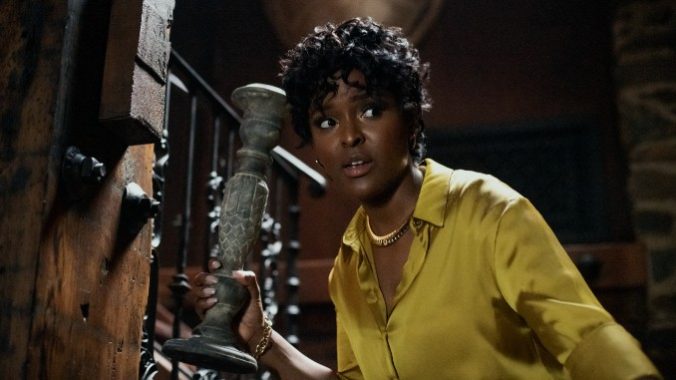The Blackening Roasts Racist Horror Tropes and Slays the Crowd

In a world where horror movies still kill “The Black Character” first, Tim Story’s The Blackening is due satirical justice. Where Scary Movie or A Haunted House type parodies have taken their swipes at exclusive racial tropes prevalent throughout horror history, The Blackening makes a more substantial mockery of the genre’s cultural omissions. Girls Trip writer Tracy Oliver and co-writer/actor Dewayne Perkins centralize Black storytelling, inherently lashing back against the whitewashed horror blueprints audiences once recognized as canon, subverting the slasher prototype with nothing but the Black experience. It’s better as a comedy than as a wickedly sharpened thriller, making The Blackening one of those surefire “see it with a crowd” pleasers.
There’s a little bit of everything in The Blackening. A group of college friends reunites 10 years later to recreate an epic Juneteenth celebration, meeting at your standard horror-grade cabin in the woods. Scream influences the structure, You’re Next the villains, Beyond the Gates the conflict—the list goes on. A group including Lisa (Antoinette Robertson), Nnamdi (Sinqua Walls), Shanika (X Mayo) and more have their horror movie knowledge tested by a crazed killer, bringing a Saw element into the fray in addition to Ghostface’s phone quizzes. That’s what happens after the characters open a tabletop game titled The Blackening (searingly dubbed “Jim Crow Monopoly”), forced to survive a deadly contest targeting their Blackness.
None of that is to say The Blackening is a copycat. Horror cinema influences future horror releases, filmmakers build upon the past, and movies like The Blackening recall familiar narratives as a means of pointing out follies. Jay Pharoah and Yvonne Orji dunk on Scream 2’s cold-open deaths of Jada Pinkett Smith and Omar Epps as possible cold-openers themselves. Multiple characters call out the dumbfounding Caucasian logic rampant in horror movies with rightful ridicule. Oliver and Perkins’ screenplay abounds with nostalgic horror references that are fresher than the lowest hanging fruit—though working in famous horror movie names for a cheap pop is inescapable even here. There’s a genuine interest in addressing horror’s failings through gut-busting roasts that sizzle and sear, especially how older horror cinema portrayed Black characters when there were hardly any Black creators behind mainstream horror releases.
-

-

-

-

-

-

-

-

-

-

-

-

-

-

-

-

-

-

-

-

-

-

-

-

-

-

-

-

-

-

-

-

-

-

-

-

-

-

-

-








































